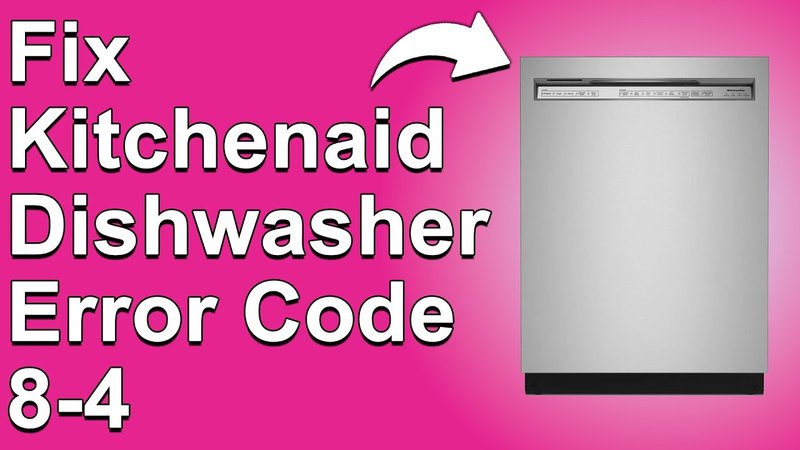
Error codes are like a secret language that your dishwasher uses to communicate with you. The OE code is particularly unhelpful if you don’t speak “dishwasher.” But here’s the deal: the OE error code generally points to an issue with drainage. Imagine a bathtub that won’t let water out because of a blocked drain. Similarly, your dishwasher can’t drain water properly, and shouting “OE” is its way of letting you know. So, let’s dive into understanding what this issue might mean, how you can diagnose the problem, and when it’s time to call in the professionals.
Understanding the OE Error Code
The OE error code on a KitchenAid dishwasher usually indicates an “overflow” or drainage issue. The appliance is essentially alerting you that there’s too much water where it shouldn’t be, possibly because the water isn’t draining out as it’s supposed to. Picture this: after a nice relaxing bath, the water just stands there, refusing to drain away because of a clogged pipe. Annoying, right? That’s what your dishwasher is trying to avoid by flashing this code.
Now, let’s break down the potential causes. The first and simplest reason can be a clogged drain hose. Like when a garden hose gets kinked, water flow is restricted, leading to backflow or standing water. In the case of your dishwasher, this means water can’t exit properly, triggering the error. Another possible culprit is a blocked filter. Imagine trying to sip a thick milkshake through a straw—it’s tough work! A clogged filter in your dishwasher similarly impedes the flow of water. Finally, the problem could lie with the pump or possibly a sensor that’s gone rogue, misreading the water levels.
So, what’s next? Well, identifying whether the problem is as simple as a kink in the hose or as complex as a faulty pump is key. While some of these issues might be fixable on your own, others certainly warrant a professional’s touch.
Diagnosing the Problem: Can You Fix It Yourself?
Before you rush to call a technician, you might wonder whether you can tackle the problem yourself first. The good news? Some of these issues are indeed DIY-level fixes. Start by checking the drain hose. Is it kinked or blocked? This is often a simple fix—just like straightening out a tangled earphone wire. Make sure there’s no food or debris clogging up the path. If that seems clear, move on to the dishwasher’s filter.
Cleaning the filter isn’t as daunting as it sounds. Think of it like emptying out a lint trap in your dryer—a little gross, but essential maintenance. If you discover a pileup of gunk, gently clean it and see if that resolves the issue. Now, if those basic checks don’t solve the problem, the issue could be more mechanical. You might be dealing with a faulty pump or a tricky sensor that requires professional tools and expertise to repair or replace.
Remember: Safety first! Always unplug the appliance before poking around. If at any point you feel like you’re out of your depth, there’s no shame in calling a technician. In fact, that’s the best course of action to prevent further damage.
When It’s Time to Call a Technician
Sometimes, even the best DIY efforts aren’t enough, and that’s absolutely okay. If you’ve checked the drain hose and filter, and the problem persists, it’s time to bring in the pros. Calling a technician ensures that the issue is handled correctly, without risking further complications. Think of it like visiting a doctor when home remedies don’t work—you need an expert to diagnose and fix the root problem.
Technicians are equipped with the tools and expertise to handle more complex issues—like a malfunctioning pump or a sensor that’s gone haywire—without causing any collateral damage. Moreover, trying to fix these yourself without proper knowledge could inadvertently void any warranties you may have on your appliance.
So, what’s your best bet? If basic troubleshooting doesn’t resolve the OE error, schedule a service call with a qualified technician. It’ll save you time, stress, and potentially, money in the long run.
Preventative Tips To Avoid Future OE Errors
Now that you’ve either fixed the problem yourself or called in a professional, let’s talk about preventing future headaches. Regular maintenance is key. Just like how you wouldn’t skip oil changes for your car, you shouldn’t ignore basic maintenance tips for your dishwasher. Ensure you’re regularly cleaning the filter and checking the drain hose for any obstructions. Keeping the area around the inlet and outlet valves clear can also help them function smoothly—think of it like clearing the gutters before a rainstorm.
It’s also wise to use the right detergent. Too much soap or the wrong type can create excessive suds that the dishwasher isn’t built to handle, leading to potential blockages and overflows. Lastly, ensure you’re not overloading the machine. Just like a backpack stuffed to the brim is a pain to carry, an overloaded dishwasher can’t perform optimally.
By following these steps, you’ll extend the life of your dishwasher and minimize the chances of encountering the dreaded OE error again. Remember, a bit of routine care goes a long way in keeping your kitchen running smoothly.
In conclusion, while encountering an error code on your dishwasher may seem daunting, it’s often just your machine trying to communicate. Understanding, diagnosing, and dealing with the OE error can often be managed at home, but don’t hesitate to call in the experts when needed. With regular care and maintenance, you’ll keep your dishwasher in top shape, ensuring it remains your trusty kitchen sidekick for years to come.